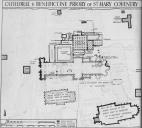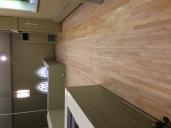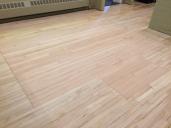Best Acoustic Choice for Floor in Choir Loft
-
Greetings all! The Church that I work for is under MAJOR renovation, and I have a very important decision: what material the floors in the choir loft should be made out of. The construction manager wants to put down plywood and cover it in carpeting squares (for easy replacing), but I'm afraid this will kill the naturally beautiful and resonant acoustic of the choir loft. The church is a 110-year-old, medium-sized gothic style church with a large cathedral ceiling. The choir loft is currently down to its original wood-slatted floor and upon (possibly unsafe) inspection, the acoustic has an enormous reverberation. I'd love to be able to retain that. So, in all of your experience, what flooring is best! Thanks in advance!!!
-
Whatever you do, don't allow the construction manager to put down carpeting, squares or any other sort.
It sounds as though you have an acoustical treasure. Protect it with your life. Is it a must that something be put over 'its original wood-slatted floor'? If so make sure that it reflects sound and does not absorb sound. Slate, either real or faux, would be one suggestion. There are a number of possibilities which I'm sure others here would recommend. -
The wording is slightly confusing: Is the original floor unsafe, or were you unsafe during inspection?
These people probably got advice from "sound engineers" who think that the ideal space is completely dead and littered with microphones. Insist that the original floor be retained: it doesn't take much to sand, stain, and seal, and could well end up being cheaper than what is proposed.
Yes, as Jackson says, you have an acoustical treasure: protect it. I must say that I am jealous (I have gross carpet in my loft that I have been desperately trying to have removed). -
Will Schill,
I get the privilege of agreeing with Jackson, and I can speak from experience.
When my headmaster asked if an organ would be sufficient for the new chapel he was building, I asked to see the organ, but I also ventured that hard surfaces were always preferable to soft ones.
Consider the following:
If we move the choir downstairs and face the people we refuse to use the cathedral ceilings as they were intended to be used; and
Once the choir is downstairs, carpet will absorb their sound; and
people will absorb the choir's sound; and
soft surfaces like coats, kneelers and such will absorb the sound.
This will require compensation, so we'll install an expensive (state-of-the-art) sound system.
Sometimes hard tiles (marble) are effective in letting the singing voice carry.
Wood is usually reliable.
If someone puts carpet in your choir loft, it will have the same consequence as at St. Michael's Cathedral in Coventry, England. (There's a giant tapestry behind the high altar, and a glass door at the west end!)
-
That giant tapestry above the high altar at Coventry is a profound depiction of Christ in Majesty, or (?) Christ Pantocrator. It was designed, I believe, by Chagall. The current cathedral is very (post-war) modern and is built over the remains of the mediaeval cathedral which was destroyed by German bombing in WWII....giant tapestry... -
Carpet??? HELL NO!!! Even it were the finest Persian carpets, I would still say, "HELL NO!"
-
Jackson,
It may indeed be a profound depiction of Christ in Majesty (I've been to the cathedral, years ago, but I don't remember the image), but it's still an acoustical nightmare. -
It was Graham Sutherland who designed this tapestry. The cathedral architecture and artistic furnishing are outstanding and help raise the mind to God. The acoustics I found thin and confused. From one experience of Evensong, I would say it does not provide a good worship space. (That's geographical north, and if you find it described as the 'Back wall of the Lady Chapel' it was written by someone who misunderstands the meaning of 'chapel').Thanked by 1M. Jackson Osborn
-
Coventry does have a fine organ. I would trade with them any day. I have heard criticism of the building since it was built, one magazine even referring to it as a "ring-a-ding God box." I have always liked that space and found it beautiful in its own unique way.
-
You could always pave the floor with the skulls of Bishops. Plenty of very hard surface there, and saves a lot of space in.........ahhh.........
-
If indeed you are down to an old wooden surface in your choir space, do save it and make the best of it. But it needs to be thick to have some even resonance. 20th c. flooring need not apply.
Our 1850's Episcopal Church in Gold Country, California, built by the conscripted shipwrights cum miners from Cornwall has thick, hand hewn, locally sawn, Douglas Fir, tongue and groove wooden planks under the overlay of plywood, rubberized padding, and regal looking thick carpet. What a sonic disaster. When I started Compline there 10 years ago, the carpet and padding in the loft had to go. After obtaining permission from the Vestry, I attacked the floor covering with gusto and my box cutter. All that removed, there was the original 19th century thick T&G fir flooring. It was already seasoned for over a century and had a few squeaks and loose boards. After about 400 drywall screws and my trusty drill-driver, the surface was tacked down securely. The difference in tone was striking. The singers could, at last, hear each other up there and the resonance was very even from top to bottom. Our Kleine German Tracker organ is well voiced but has no expression, and no stop less than mf, so I left the area around the organ itself with a halo of carpeting: a kind of instant EQ.
My next job is to paint the floor and sub walls in the loft with something called 'porch paint', a very hard and durable reflective surface mixture, thicker than paint with a fibreglass additive that reflects the highs more than the lows. I like the resulting sound better than with marine epoxy coatings. I built a portable floor covering for the front of the Nave with 4 foot x 8 foot x 17mm hardboard sheets (with clips) that fit like a puzzle in the space and allows the choir or whomever is performing there to hear each other and generate a modicum (that's Latin for a medium amount 8<) of reverb. They are all painted with the royal maroon porch paint to match the pews, and unfortunately the carpet. The singers were happy with the big difference in resonance.<br />jefe -
Our choir loft floor was redone recently and with linoleum squares instead of carpet. The wood beneath was too nasty to leave alone. This has worked out nicely.
-
The floor should be as hard as possible. No carpet or absorbing materials at all it's really simple.
-
Those skulls of bishops sounds hard to beat. My church has hickory flooring which works well.
-
As an update on our 1850's T&G fir flooring (about 22mm thick), the sound has actually gotten better over time. The difference is there is no paint or coating on the old wooden planks in the loft, and over time has gotten very shiny and more reflective from foot traffic. But, please do not move around up there bare footed.
-
If carpet is put down, you could put a couple of “stray cats” in the choir loft Sunday after mass and accidentally discover them Tuesday after the damage has been done. Jk
-
The current cathedral is very (post-war) modern and is built over the remains of the mediaeval cathedral which was destroyed by German bombing in WWII.
@MJO The current post war 'cathedral' is built next to the ruins of the previous 'cathedral' (St Michael's 14th c.), this building was only a large parish church, the mediaeval Cathedral and priory (St Mary's 12th c.) was destroyed by Henry VIII. The ruins were found recently. -
BackgroundIn the 1990s, a national poll saw Coventry Cathedral elected as the nation’s favourite 20th Century building.

 cathedral-plan-coventry-1024x920.jpg1024 x 920 - 286KThanked by 1M. Jackson Osborn
cathedral-plan-coventry-1024x920.jpg1024 x 920 - 286KThanked by 1M. Jackson Osborn -
as the nation’s favourite 20th Century building.
What was its competition?
Remember: Theresa May or ….
Donald Trump or ….
Fascists or ………
-
Tip: if you post a comment that contains a link and nothing else, the forum software *will* mistake it for spam, and put it on hold until I release all the copies you submit. Try posting a *comment* in your comment!
-
One year ago, we removed the carpet from our choir loft and refinished the wood floor. The floor is made out of maple, but there is a cutout in the center where there is pine, which shows us where a pipe organ once stood. Too bad they tore that out! Now I'm stuck with a 1988 Allen "Organ".
The church itself is a small country church that seats about 250 people. It was built in 1868. The choir loft was added in 1905.
 IMG_5209.JPG3264 x 2448 - 1M
IMG_5209.JPG3264 x 2448 - 1M
 IMG_5208.JPG3264 x 2448 - 1M
IMG_5208.JPG3264 x 2448 - 1M -
2.25 tongue in groove oak is preferable if the floor moves a big like a lot of old choir lofts.
Do NOT GET PREFINISHED, many a construction guy makes this mistake when it comes to flooring, it's all the rage but it's utter crap, not because of it's finish but because when it's sealed in place the acoustic qualities are MUCH more prevalent.
https://www.hursthardwoods.com/2-1-4-x-3-4-red-oak-3-common-unfinished-solid-hardwood-flooring/
Having worked construction before a full time music gig I can tell you that the choir lofts with this type of flooring were a joy to have music in. Also, you can stain them very dark brownish with some deep burgundy and you get an extremely elegant looking floor too.
If it's a solid floor 12inx12in solid terra cotta tile would be the best choice. The acoustic qualities are fantastic!!!
https://www.flooranddecor.com/quarry-tile/spanish-red-quarry-tile-915307457.html
Blessings!! And I'm praying for a good solution.
Welcome to the MusicaSacra Forum!
To participate in the discussions on Catholic church music, sign in or register as a forum member, The forum is a project of the Church Music Association of America.
Categories
- All Discussions21,162
- General Music Discussion8,239
- Job Openings204
- Management of Music Programs850
- Choral Matters533
- Church Documents and Rubrics526
- CMAA Notes304
- Events720
- For Newcomers: Read First26
- Sacred Polyphony547
- Hymnody872
- Gregorian Chant: General2,703
- ↳ Graduale Romanum and Liber Usualis369
- ↳ Graduale Simplex60
- ↳ Semiology63
- Vernacular Plainsong696
- Anglican Use and Anglican Chant68
- Organ, Other Instruments and Repertoire435
- New Composition/Works in Progress1,295
- Recordings234
- Music for Hispanic Ministry159
- Music Education: Children211
- Music Education: General222
- News Items245
- Positions Wanted2
- General Discussion: Catholicism740
- Amusements177
- General Discussion1,035
- Opinions119




